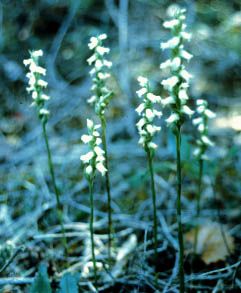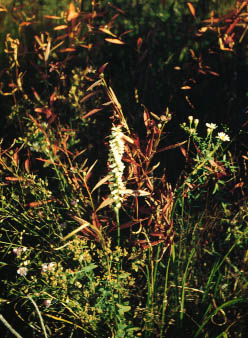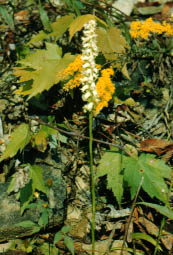



Identification
Spiranthes cernua, first described by Linnaeus and
then later modified by L.C. Richard (Chapman,
1997) is described by Chapman as follows:
Leaves 3-6, 5-20 cm (2-nearly 8") long, long and slender with a distinct stalk, most growing from the base of the stem, green, present during flowering. Stem 15-38 or up to 50 cm (6-15 or up to 20") tall, pubescent on the upper portions, with several sheathing bracts, green. Inflorescence 1/4 -1/3 of the total stem, usually 7.5-10 cm (3-4") long, with 15-30 or up to 60 flowers, flowers usually densely arranged and three-ranked. Flowers about 7-8mm (1/4 - 3/10") tall and wide, 10 mm (2/5") long, tubular, white often with a yellowish or greenish center. Sepals and petals similar, about 10 mm (2/5") long, narrowly lance-shaped, white; dorsal sepal and petals converging to form a tubular hood over the lip, tips of all three parts curved slightly upward, lateral sepals pressed against the petals, tips curved slightly inward; lip about 10 mm (2/5") long, egg-shaped and slightly constricted near the center which is wavy and usually minutely toothed outer margin, tips strongly downturned or recurved, white with yellowish or greenish near the base. (Chapman, 1997)

A sample of Spiranthes cernua is deposited and can be found at the
University of Georgia Herbarium, Athens, Georgia.
This species can be found in an identification key in the following source:
Chapman,
William K. 1997. Orchids of the Northeast - A Field Guide.
Syracuse University Press. Syracuse, New York. p 69-70.
Geography
Spiranthes cernua is generally found throughout
the eastern half of the United States, excluding Southern Florida and Northern
Maine (Chapman, 1997).
|
|
|
|
| North America |
|
Jones & Coile, 1988 |
| Eastern North America |
|
Chapman, 1997 |
| Southeastern United States |
|
Chapman, 1997 |
| Southern Appalachian States |
|
Chapman, 1997 |
| Coastal Plain |
|
Chapman, 1997 |
| Piedmont |
|
Jones & Coile, 1988 |
| Blue Ridge Mountains |
|
Monica Gupta, Pers. Guess |
| Great Smoky Mtns. National Park |
|
Chester et al. |
| Ridge and Valley |
|
Monica Gupta, Pers. Guess |
| Cumberland Plateau |
|
Monica Gupta, Pers. Guess |
| Central Arch |
|
Monica Gupta, Pers. Guess |
| Georgia |
|
Jones & Coile, 1988 |
| Clarke County, Georgia |
|
UGA Herbarium |
| Sam's Farm |
|
Monica Gupta, Pers. Obs/Guess |
Natural History
Spiranthes cernua, as well as many other Spiranthes
species, tend to be found in open moist areas. Thus, it can be concluded
that Spiranthes cernua requires a moist, wet environment for growth
such as that found in bogs, ditches, or swampy fields (Cullen,
1992). They are primarily found in temperate zones/areas, most
of which are in North America.
"Individual colonies seem to be somewhat transient; they rapidly colonize
newly created habitats but thrive only in the early stages of succession.
This is an effective strategy, and is abetted by an accelerated life cycle.
Seeds mature rapidly, and new plants can apparently reach reproductive
size in only two years" (Smith,
1993).
How to Encounter
Spiranthes cernua is often found in open moist areas,
such as roadside ditches, the edges of swampy fields, and springs (Chapman,
1997). Small colonies are also found growing in bogs, wet
meadows, stream banks, and moist open woods and fields (Gupton,
Swope, 1986). This orchid can be found throughout the eastern
United States, as well as the southeastern tip of Canada (Chapman,
1997).
The flowering season of this species is usually the third week of August
to the first week of October(Chapman,
1997).